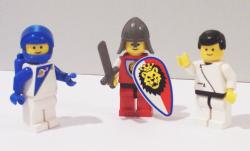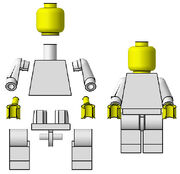
Space, Castle and Town minifigures
Minifigures are the small, plastic LEGO people, who populate the Lego worlds. Most Lego sets include some minifigures; LEGO has also sold collections of minifigures as separate sets. They are also known as minifigs or "LEGO people".
Design

Anatomy of a LEGO minifig
Minifigures are composed of several separate parts: head, torso, arms, hands, hips and legs. Minifigures typically come as three separate parts in Lego sets: head, torso/arms/hands, and hips/legs.
The legs can rotate independently to 90 degrees forwards, and about 45 degrees backwards. They also attach to normal Lego bricks in either a sitting or standing position. The hands of a minifigure make a "C" shape, which allows them to hold many Lego accessories. There are hundreds of different accessories, including axes, wands, cups, guns and even food. The tops of the hands are also roughly the same size as the studs on Lego bricks, allowing various Lego pieces to be placed on top of them. Minifigure heads are cylindrical, and attach to long narrow cylinder at the top of the torso, which allows the head to rotate. This also allows items that go over the torso, such as air tanks, capes or breastplates, to be attached. The heads also have a stud on top (which is the same size as studs on Lego bricks), which things can be attached to. Head accessories are varied, including hair, helmets and hats. These variations allow minifigures to be highly customizable.
History
The first minifigures were released in 1978, with seven different figures in Castle, Space and Town themes. [1] Until 1989, minifigure heads only had a simple facial expression of two black dots for eyes, and a black curved smile. In that year, minifigures in the Pirates theme were produced with different facial expressions. [1] The Pirates minifigures also included hooks for hands, and wooden legs, the first departure from the traditional hands and legs. In 2003, the first minifigures with natural skin-tones – as opposed to the yellow previously used – were released as part of Basketball; these minifigures also represented specific people. [1] The following year, the use of natural skintones was expanded to licensed products, such as Harry Potter and Star Wars minifigures. [1] As of 2003, Lego has produced 3.7 billion minifigures. [2]
Variations
While almost all minifigure torsos, arms and legs are the same size and shape, some sets and themes have included figures that differ from the standard. Some minifigures for women, particularly in Castle and Pirate sets, have used large sloped bricks instead of legs to resemble Dresses or Skirts. Skeletons, in Pirate and Castle sets, have the standard minifigure head, but have specialized skeletal arms, legs and torso (which are still detachable from each other). Shorter legs, without joints at the hip, have been used for children, Yoda and Ewoks in Star Wars sets, Goblins and House Elves in Harry Potter sets, Dwarfs, in Castle, SpongeBob and Mr. Krabs in the SpongeBob SquarePants sets and Short Round in the Indiana Jones sets. Pirate minifigures have had peg legs and Hooks for hands. Hagrid, from Harry Potter, uses a larger minifigure, with only the head being separable. Recently, some minifigures have also had heads that differ from the traditional cylindrical shape. Traditional accessories, such as hats and helmets, cannot be placed on these different heads. Examples include Yoda, Ewoks, Dobby and goblins as mentioned above. Some minifigures, such as Chewbacca, SpongeBob, and ewoks, have head pieces that fit like ordinary heads, but end up covering more.
Child-friendly versions of minifigures, which are much more difficult to take apart, are being designed. Also, some of the newer figures have special transparent features that can light up (such as lightsabers and flashlights). While this adds a new feature, these minifigures cannot come apart into as many pieces, which could discourage those who wish to customize them.
Minifigures built from special pieces were first introduced in Life on Mars. Martians are builds for five pieces: 2 Double arm, mechanical torso, a combined leg piece and a head. This formula is repeated for many Star Wars droids. Battle droids follow the same pattern, while Super Battle Droids have the head fixed to the torso, General Grevious has space for 4 arms and IG-88 has a head constructed from Lego elements. Other droids, such as Droidekas, Spider Droids and Pit Droids, are constructed entirely from ordinary Lego elements, but are none the less often considered minifigures. R2-D2, and other astromech droids, are constructed from specialized elements; with a separate top, body and 2 legs. Recently, the robots of Exo-Force have a design similar to the battle droids, but have separate legs and movable hands, and the head fixed on small torso.
Lego Storylines
Lego has made several "systems," where there are particular sets that have a central theme or story. Some examples include the Orient Expedition, Lego Star Wars, Alpha Team, Knights' Kingdom and Knights' Kingdom II. Some of the minifigures from these sets are from popular movies or series such as Star Wars, Batman, Indiana Jones and Harry Potter. Also, Lego has some spinoffs or spoofs of popular series. Alpha Team was a theme were minifigures in the team fight agianst Ogel. In 2004 the LEGO Group established sets that included minifigures based on real actors, their skin tone would change accordingly. Hence the flesh toned minifigures seen in recent Star Wars sets. The Exo-Force storyline features minifigures with colorful anime hair.
Other Lego figures
In some lines of products, Lego has used figures other than the standard minifigures. Technic has used larger minifigures since 1986. These figures are more realistic, although still angular, and have more degrees of motion, including knees and elbows. However, they cannot be easily disassembled; even hair is non-removable. The Fabuland line of the 1980s consisted of larger anthropomorphic animal characters, which also couldn't be easily disassembled. Belville and Scala, Lego lines aimed at girls, also have larger figures. They are similar to Technic figures in range of motion, but have less angular legs, arms and torsoes. Scala figures more closely resemble Dolls, in that clothes are separate from the figures and the hair is composed of strands and not molded plastic. More recently, Lego has introduced Bionicle figures, such as Toa, which are many times larger and have more flexibility in pose; they are also composed of separate pieces, unlike other large Lego figures. In 2005, Lego released Bionicle playsets, with minifigures of characters that previously only had large figures (Toa and Visorak/Piraka). While these minifigures did not have movable parts, in 2006 Lego released Toa Inika playsets containing minifigures with movable parts. another type of minifigures are the figures found in the Jack Stone sets, and they have carved faces, but are bigger, and do not have interchangeable parts. Without a doubt, the minifigure is the most popular product.

